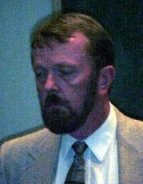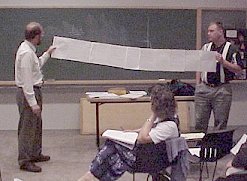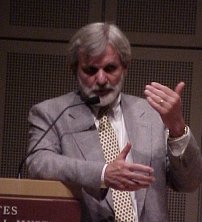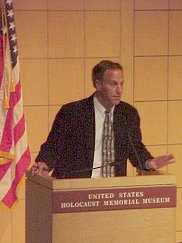

The US Holocaust Memorial Museum hosted the Arthur and Rochelle Belfer National Conference for Educators during the days of July 25, 26, and 27. The stated purpose of the conference was to provide educators with additional insight on how to present the Holocaust to middle and high school students.
 |
Teachers from all over the nation
come to Washington to gain knowledge and skills.
Top: Peg Rinkenberger (MN), Pam Blevins (OK)
Bottom (left to right): Pat Fellers (KS), Susan Johnson (NC) Marj Iven (OK).
Sunday, July 25, 1999
 Participants attended workshops on a variety of topics. The workshops
were presented in two strands: middle and highs chool. One local high school history
teacher, Mr. Robert Hines of Richard Montgomery High School in Rockville, Maryland
delivered a series of discussions on Holocaust documents and how these can be used in the
classroom to get students thinking historically about the Holocaust. Mr. Hines is his
school's social studies department chair. He is a 1998-1999 Mandel Fellow of the US Holocaust
Memorial Museum.
Participants attended workshops on a variety of topics. The workshops
were presented in two strands: middle and highs chool. One local high school history
teacher, Mr. Robert Hines of Richard Montgomery High School in Rockville, Maryland
delivered a series of discussions on Holocaust documents and how these can be used in the
classroom to get students thinking historically about the Holocaust. Mr. Hines is his
school's social studies department chair. He is a 1998-1999 Mandel Fellow of the US Holocaust
Memorial Museum.
Mr. Hines told his audience today to help students focus on the language of the Holocaust before examining the events. He assigned his class of teachers some homework: to look for certain documents in the museum's permanent exhibit and be ready to report on their nature and significance.
Much of Mr. Hines' presentation centered around the documents found in the exhibit entitled "The Hidden History of the Kovno Ghetto." The exhibit at the Museum is extensive. It chronicles the struggle of the Kovno Ghetto in Lithuania to survive and document its own persecution. The documents found in the exhibit provide students of the Holocaust an excellent first-hand look at how ghetto life must have been under nazi rule and domination. It also provides students of history with an excellent opportunity to refine skills of historical inquiry and documentation.
 Mr. Hines also led teachers
through an examination of US policy
toward the Jews of Europe during the years of the Holocaust. We examined documents
that illustrated America's slow response in assisting Europe's Jews, including barriers to
immigration. In the image at right, Mr. Hines is demonstrating the length of an
application for an American visa that a Jewish refugee might have had to complete before
being considered for entry into the United States during the 1930s and early 1940s.
Mr. Hines also led teachers
through an examination of US policy
toward the Jews of Europe during the years of the Holocaust. We examined documents
that illustrated America's slow response in assisting Europe's Jews, including barriers to
immigration. In the image at right, Mr. Hines is demonstrating the length of an
application for an American visa that a Jewish refugee might have had to complete before
being considered for entry into the United States during the 1930s and early 1940s.
All of the conference attendees gathered to listen to Dr. David Crowe, professor of Russian History and the Holocaust at Elon College. Dr. Crowe is a member of the Education committee of the Holocaust Museum.
 Dr. Crowe delivered a
lecture on the history of the Roma, or Gypsy population of Europe, and their place
in the Holocaust legacy. His lecture, delivered completely without notes, helped dispell
many of the stereotypes concerning the Roma, and he put their experiences in the proper
historical context.
Dr. Crowe delivered a
lecture on the history of the Roma, or Gypsy population of Europe, and their place
in the Holocaust legacy. His lecture, delivered completely without notes, helped dispell
many of the stereotypes concerning the Roma, and he put their experiences in the proper
historical context.
One of the ost moving highlights ofthe day came during the survivor testimonies of Charles Hofmann and Tania Rozmaryn. Charles was a passenger of the ill-fated refugeeship, the St. Louis, and Tania told us of her escape from death as a survivor of the Kovno ghetto. The Kovno Ghetto, in Lithuania, wasthe scene of horrific atrocities by the Nazi action groups. Both speakers sparked thoughtful questions and serious reflection among the attendees.
|
|
|
Charles discusses the voyage of the St. Louis. |
Conference Director Warren Marcus listening to survivor testimony. | Tanya kept the audience spellbound. |
Tonya told us how she overcame post-traumatic stress syndrome, and how she recaptured her faith after the war.
Charles also told us about how he continues to struggle with issues of faith after the war, and how he continues to come to terms with the views of his fellow survivors.
Said Tanya: "It was not God who killed my 6 million brothers and sisters. It was Man."
Also: "Hitler's goal was to destroy Judaism. If I abandoned my faith, I would have been an accomplice"
Charles: "Every day, I count my blessings."
|
Left: Charles Hofmann
Right: Tanya Rozmaryn |
|
Tanya: "I trust the goodness of human nature because there are many more good people than bad."
The Annual Writing Contest
 Each year, the museum
sponsors an art and writing contest open to middle and high school students. This year's
writing contest focused on the resistance of those who experienced Nazi persecution.
Pictured here, the winner accepts her award.
Each year, the museum
sponsors an art and writing contest open to middle and high school students. This year's
writing contest focused on the resistance of those who experienced Nazi persecution.
Pictured here, the winner accepts her award.
| Conference Director Warren Marcus acted as our master
of ceremonies and closed the conference with a directive to return to our classrooms with
enthusiasm for our topic tempered with serious scholarship. He encouraged the Belfer
teachers to stay in contact with the museum and with each other as we struve to develop
connections and conclusions about the Holocaust.
|
 |
To The Interdisciplinary Units Page |
To The Beast Within Page |
To What is Race? |
To the Belfer Holocaust Education Conference |